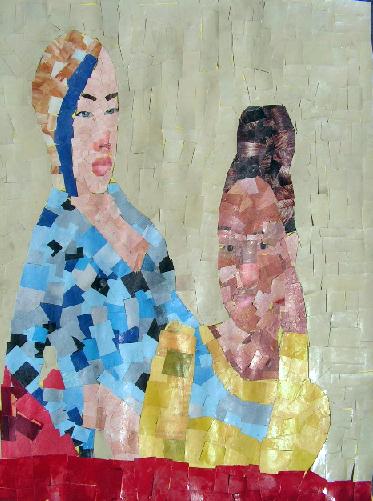 Shop On-Line at the Art of Essex
Shop On-Line at the Art of Essex
 Shop On-Line at the Art of Essex
Shop On-Line at the Art of Essex
|
|
Lesson Plan: Paper Mosaics & Collage. Unit Plan " A Jazzy Renaissance" A Cultural Experience for the 21st Century
Unit Plan: A Jazzy Renaissance
Teacher:
Essex Garner Art Strands: Making Art, Art History, Art
Criticism, Grade levels: 9 through 12
The Big Idea: This is the second lesson of three within the "Jazzy Renaissance" unit of instruction. Class time allotted for each lesson is one hour. |
Jacob Lawrence Jacob Lawrence Mosaic (Boy
with Kite)
|
|
Conceptual Structure: Jazz emerged from the heart of New Orleans. It played a significant role in the building of Americaís cultural landscape. America has a growing population that is rich in cultural diversity like the many pieces of mosaic artwork we will be working on in this lesson. As we follow the Great Migration of almost two million African Americans to the northern cities from the previous lesson. We also understand they took not only their new music genre with them, but were the driving forces of the period known as the Harlem Renaissance. Itís important to understand at this time that African American literature was finally being taken seriously just like the Jazz renaissance in Southern states. Although this movement initially focused on literature led by the poet Langston Hughes, it evolved to include, art, theater, music, and politics. Although African American music, art, and literature had crossed the racial divide laws like the Supreme Court case of Plessy v. Ferguson that declared racial segregation constitutional kept this mosaic fabric of America separate and unequal. Northern states unlike the South allowed all African-Americans adult men, the rights to vote and educational opportunities. These social and political gains were marginalized behind the Great Depression initiated by the Stock Market Crash of 1929. By 1935 to preserve the skills and self-respect of the unemployed during the Great Depression, Franklin D. Roosevelt under the New Deal established the Works Process Administration (WPA) to stimulate the economy. This organization also governed the WPA Federal Art Project, which provided jobs for unemployed artists, actors, and writers not excluding many talented African Americans. Main Ideas and Introduction: Show to your students the different mosaic work that adorns historic Islamic and Roman Architecture of the past, and of many current era. Ensure that your students are able to distinguish the differences between crafts and Fine Art. Review with your students some of the artists from the Harlem Renaissance, especially those that worked within the WPA. (Here is a short list of WPA artist that you can use for this lesson). Click to activate listing.
|
The Revolution Is
Televised Art Fundamentals III
student work. |
|
1. Goals and Objectives:
2. Lesson Concepts: Make sure your students understand that the mosaic they will be constructing can represent a social statement they are trying to convey. Ask students if they believe the definition of a "mosaic cultural" could be defined to much more than a collage of deferent diverse groups of their cultural heritage. Next, see if they are able to make those connects that are reflective in todayís global society. Make the connections many of these artists made within the stylized and idealized approach to the West African art motif, and the connections they references politically in their art to the slave trade and Jim Crow standards their predecessor had to undergo. Remember that this is a good time to teach your students "the best way not to repeat bad things in history, is to know your history". 3. Instructional critical study:
The students will digitally record and comment on their work and with their peers. Students will ask the questions: "do you think your artwork changed or effected someoneís opinion concerning the social issues of others"? |

Rap Girls
Art Fundamentals III student work.
Roberto Clemente
Art Fundamentals II student work. |
4. Art making activities (What to do):
5. Instructional critical studies:
|
Looking Back
Art Fundamentals II student work. |
Clean Up: Allow 5 minutes or more if needed to accomplish this before class ends. What you will need:
|
Vocabulary: Digital Media |
|
|
|
|
Useful Internet Links:
African-American Mosaic (WPA) (2010). A Library of Congress Resource
Guide for the
Study of Black History & Culture. Retrieved
November 10, 2010, from
http://www.loc.gov/exhibits/african/afam012.html
Celebrate Black History: The Harlem Renaissance (2009),
November 9, 2010, from
Celebrate Black History: The Harlem Renaissance
Charlie Parker (Frank Driggs
Collection) (2009);
Retrieved September 23, 2010, from
http://www.pbs.org/jazz/biography/artist_id_parker_charlie.htm
Encyclopedia Britannica.com (2010). Arts & Entertainment: Harlem
Renaissance. Assorted References; in African American
literature:
The Harlem Renaissance. Retrieved November 9, 2010, from
http://www.britannica.com/EBchecked/topic/255397/Harlem-Renaissance/272829/Drama
Garner, E. (2010). Reading Writing and Arithmetic. Art and
Developmental Lesson Plans.
Retrieved April 2, 2007, from
essexgarner.com/artlessonplans
Lawrence, J. (1997). Toussaint LíOuverture Series by Jacob Lawrence.
The High Museum,
"Over the Line: The Art and Life of Jacob Lawrence".
Retrieved November 9, 2010, from
http://www.alitashkgallery.com/lawrencetl/
McNulty, Ian (2010). History New OrleansFrenchQuaters.com. First
Notes: New Orleans and the Early Roots of Jazz.
Retrieved October 29, 2010, from
http://frenchquarter.com/history/JazzMasters.php
New Orleans Website Directory (1999). New Orleans & Louisiana Bands
& Musicians. Retrieved
November 9, 2010, from
http://neworleanswebsites.com/cat/en/mu/m-bm/m-bm.html
Additional Resourses:
Creativity Connections & Classroom Implications & Applications
![]() Blog
Information for Artistic Thinking
Blog
Information for Artistic Thinking
|
|
|
 |
|
 |
|